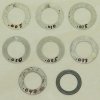Lucky Strike
Member
I've got a Dillon 550B and use dillon dies and the setup works good once the dies are set. I am wanting to get more into experimenting with different recipes and bullet types though and setting the seating die is definitely a frustrating experience. I want to get one with a micrometer adjuster to make things easier.
I know they're spendy but after dealing with setting the seating die to a specific depth again last night I will gladly pay the premium $.
Just wondering which of the ones out there gives the best performance as far as accuracy/precision of the micrometer adjustment.
this is for 9mm
I know they're spendy but after dealing with setting the seating die to a specific depth again last night I will gladly pay the premium $.
Just wondering which of the ones out there gives the best performance as far as accuracy/precision of the micrometer adjustment.
this is for 9mm






